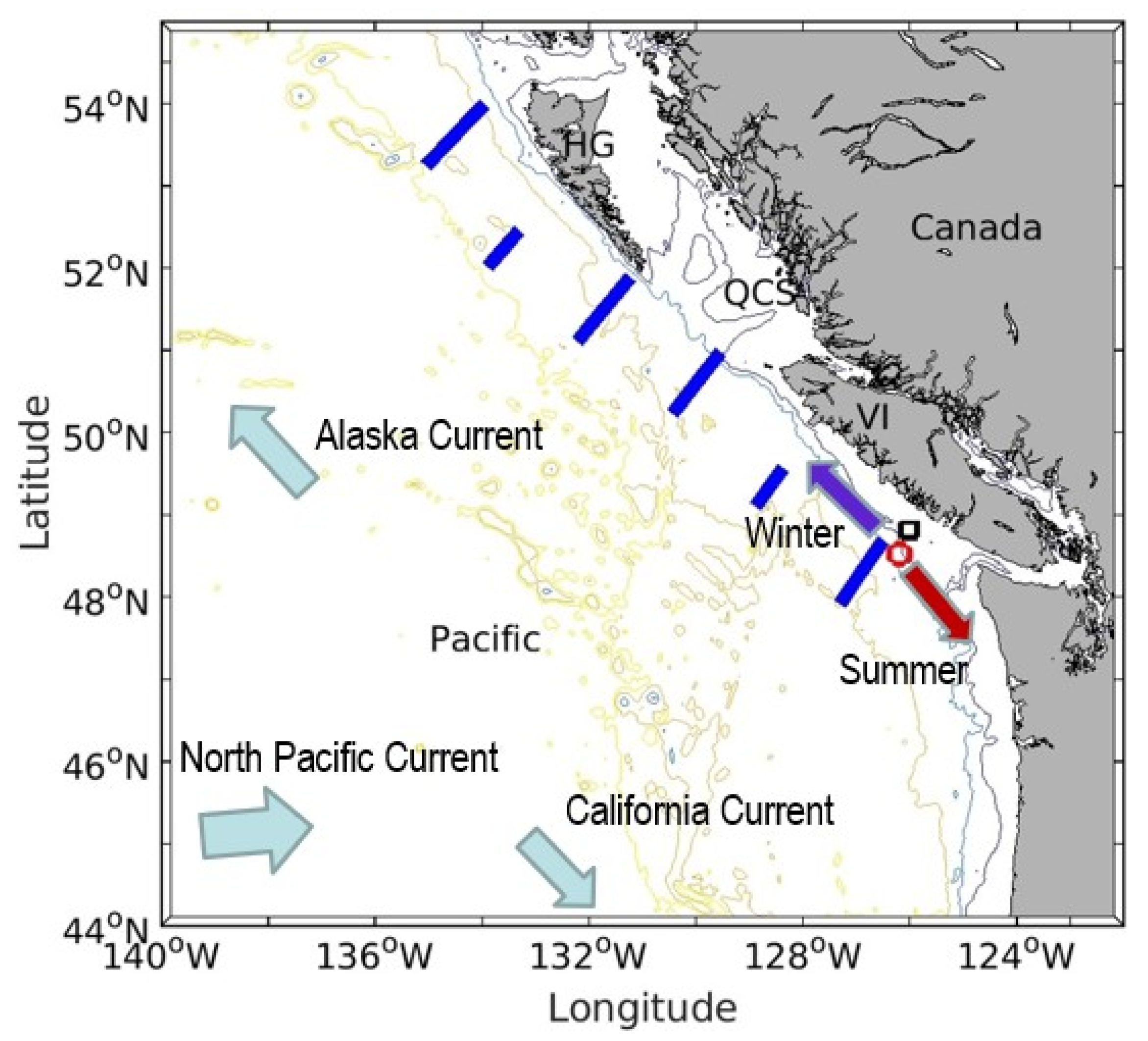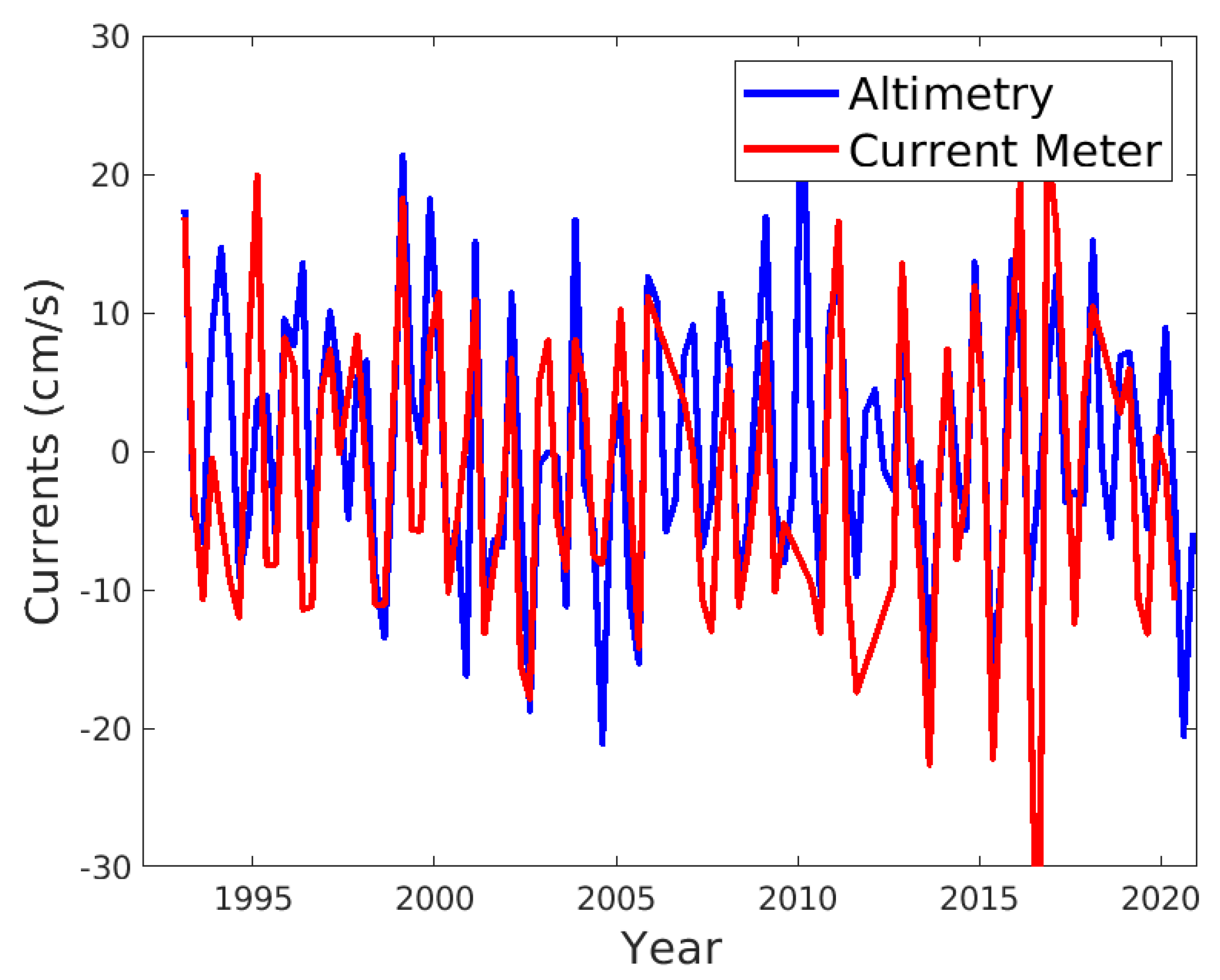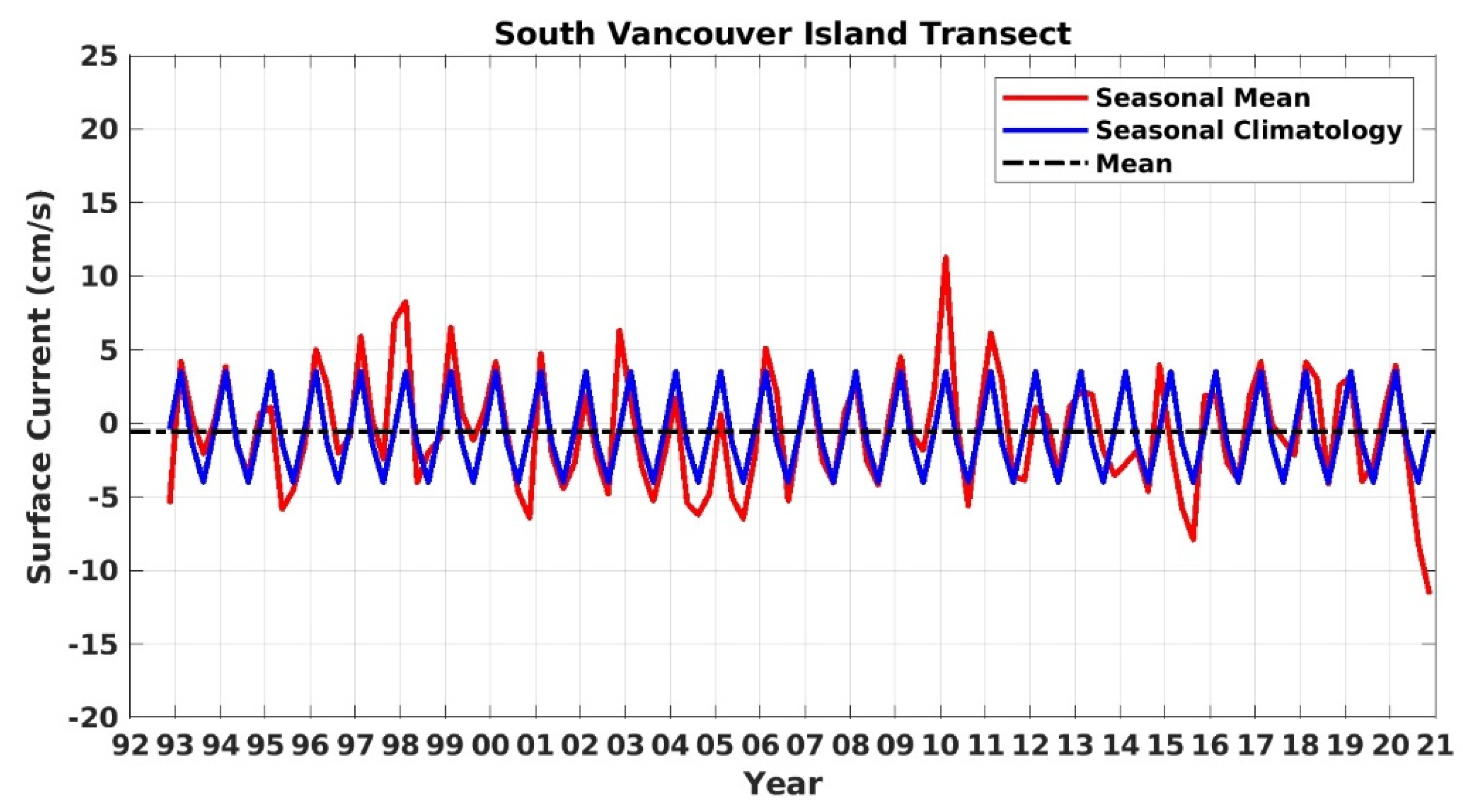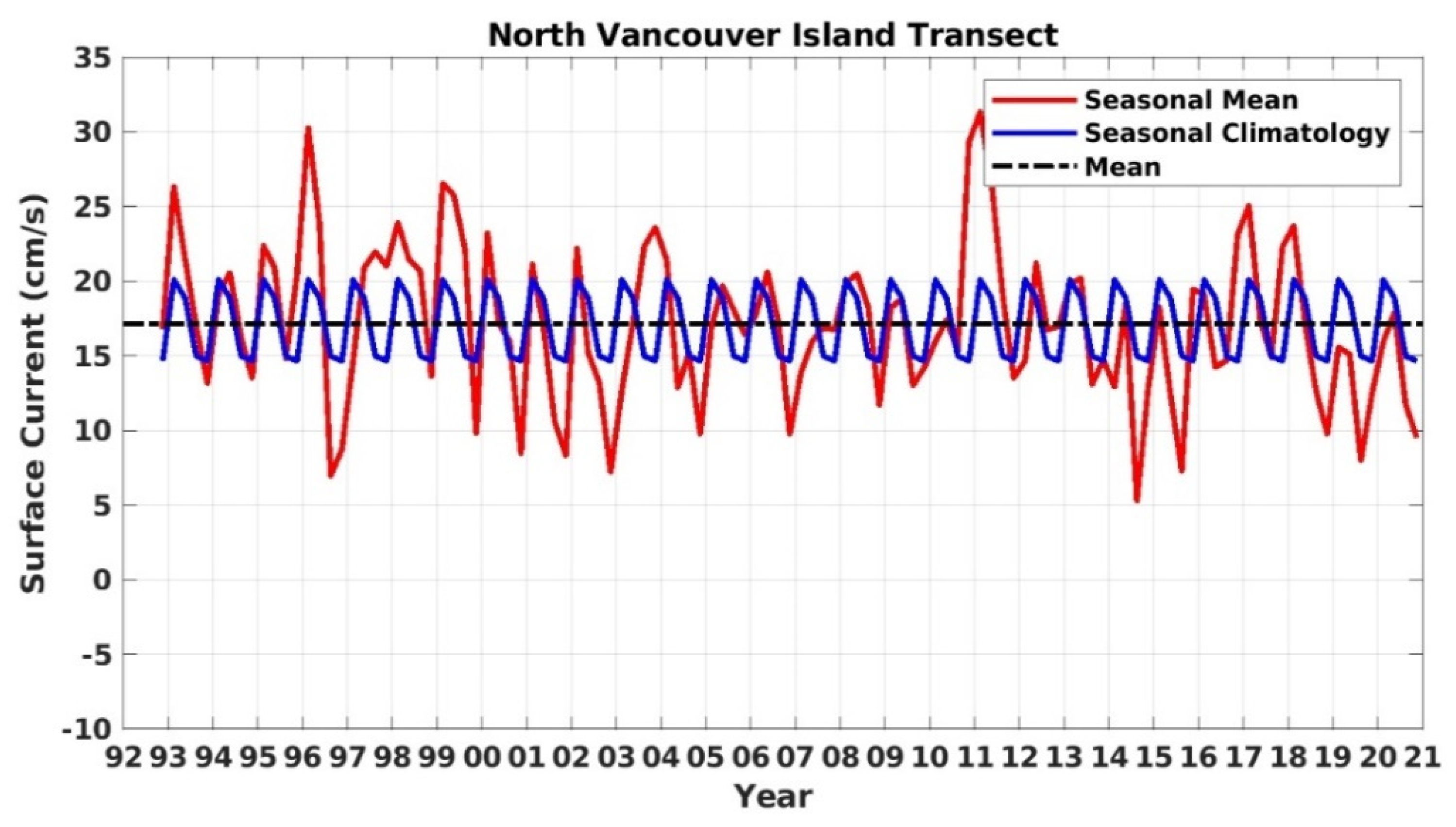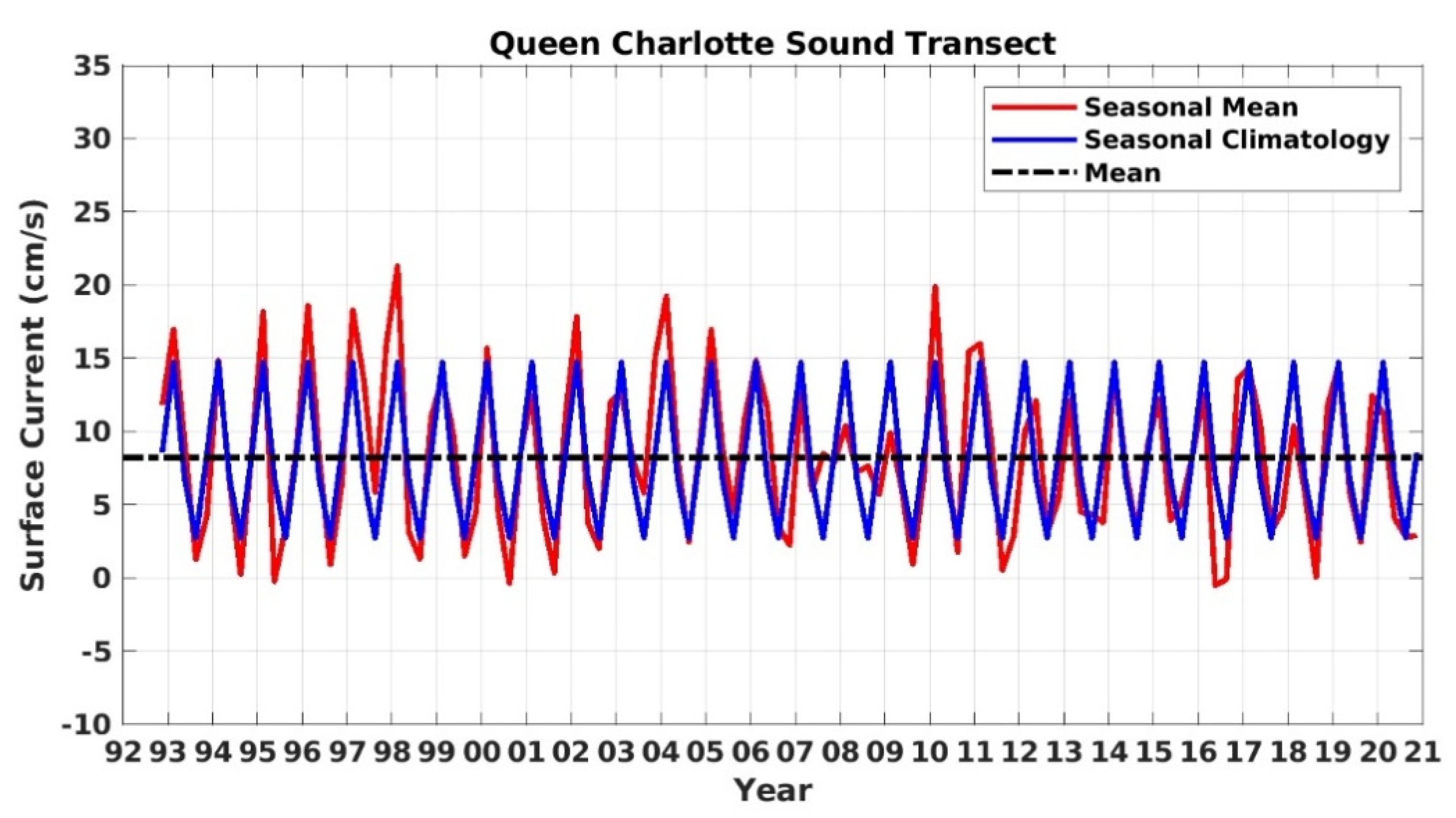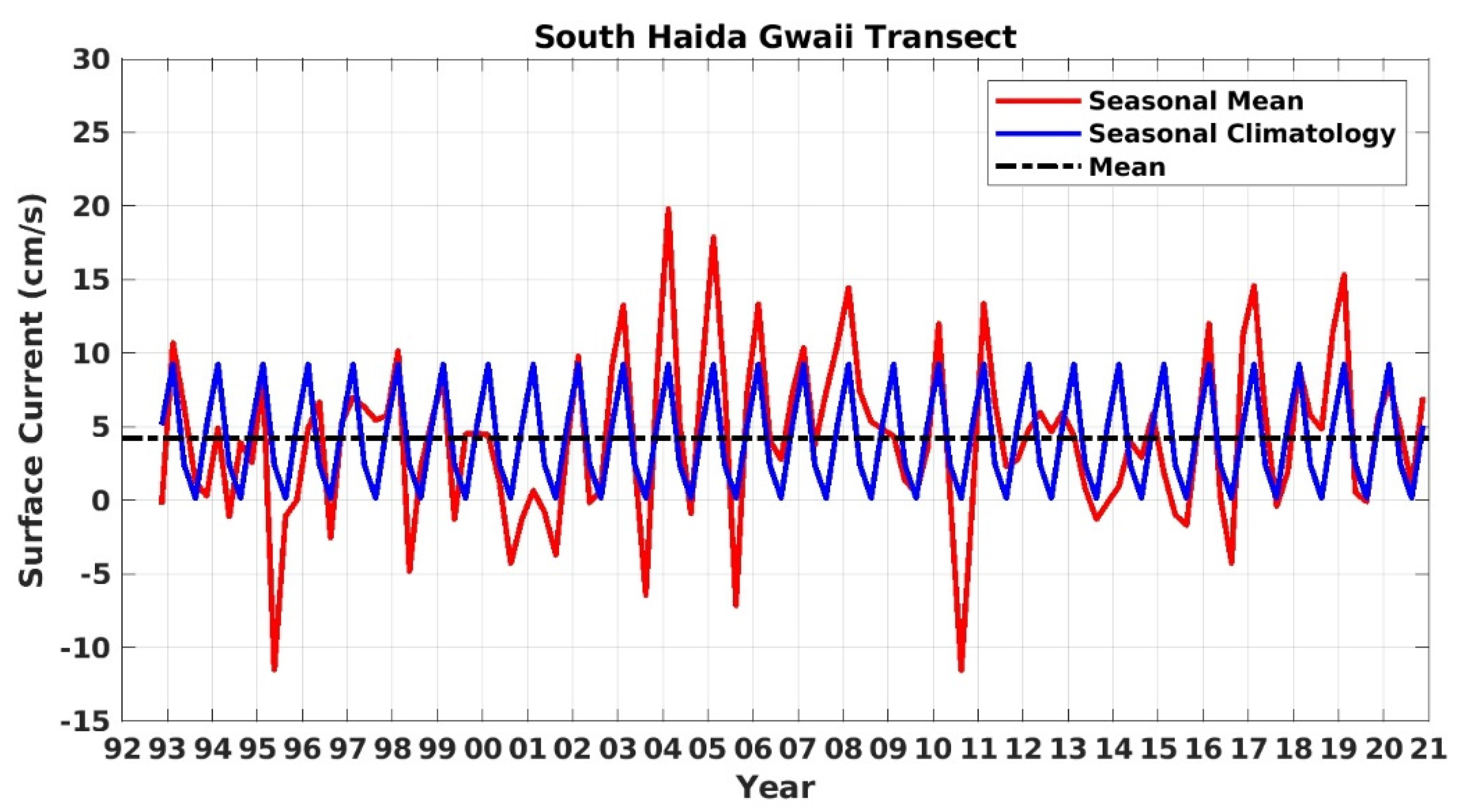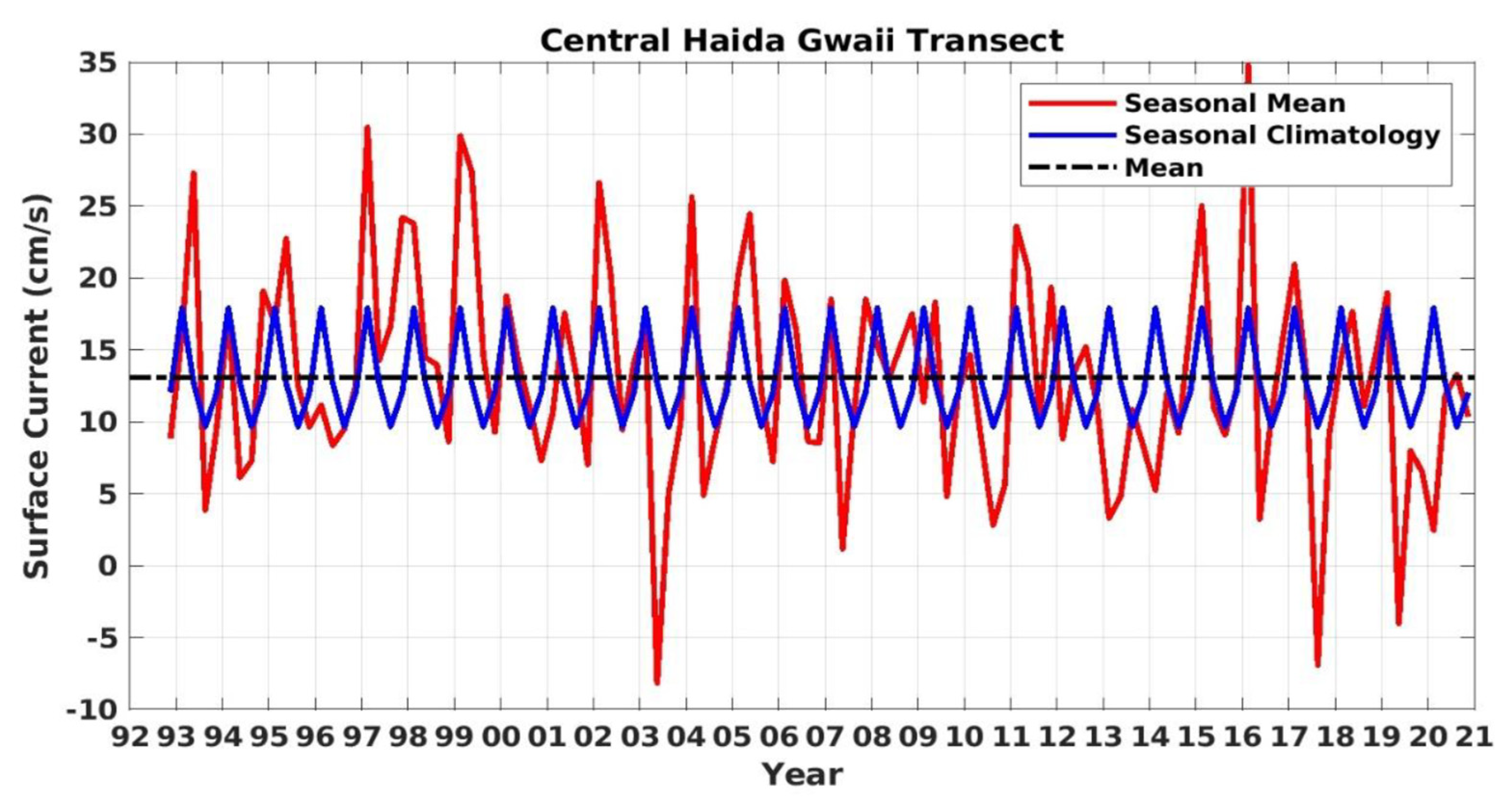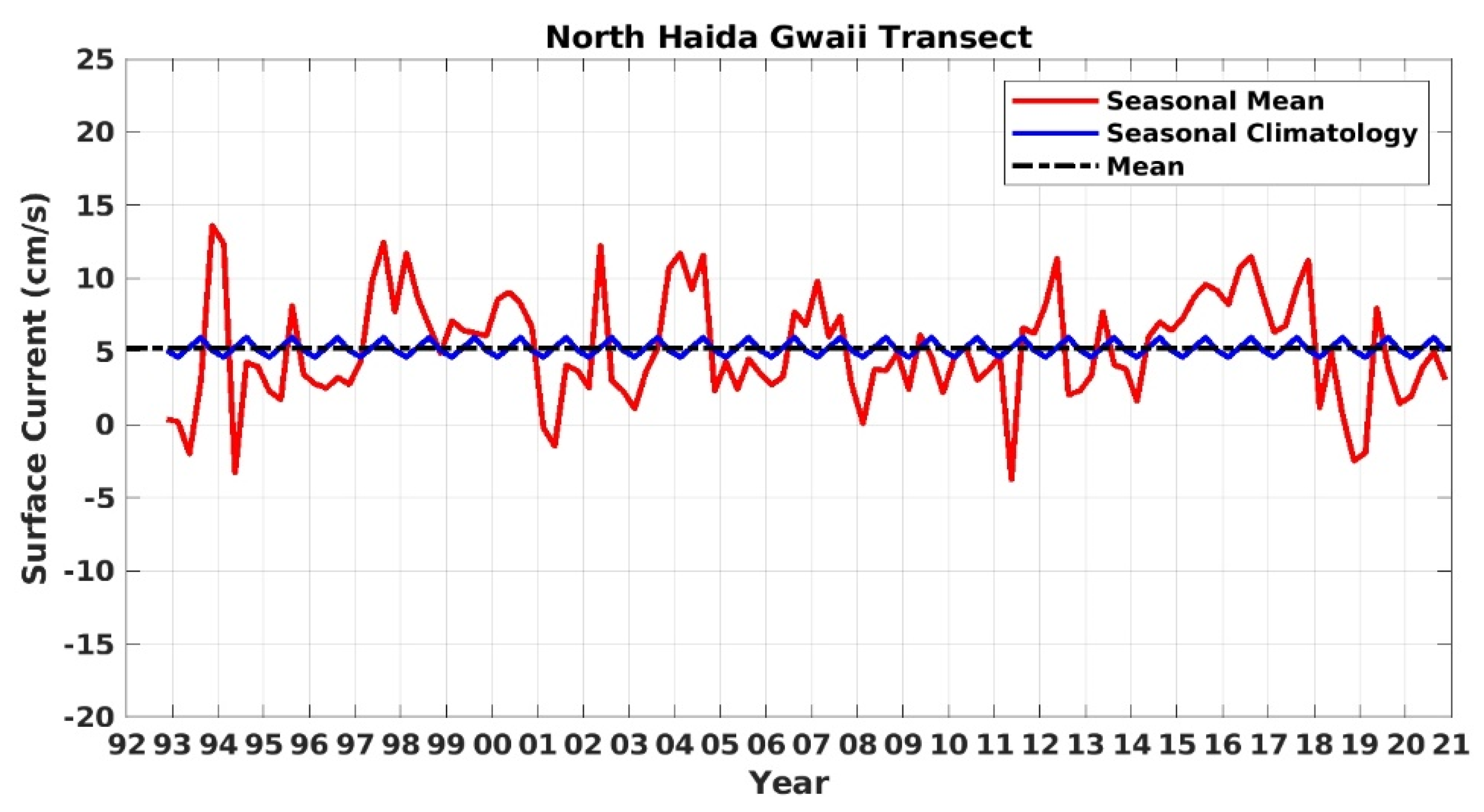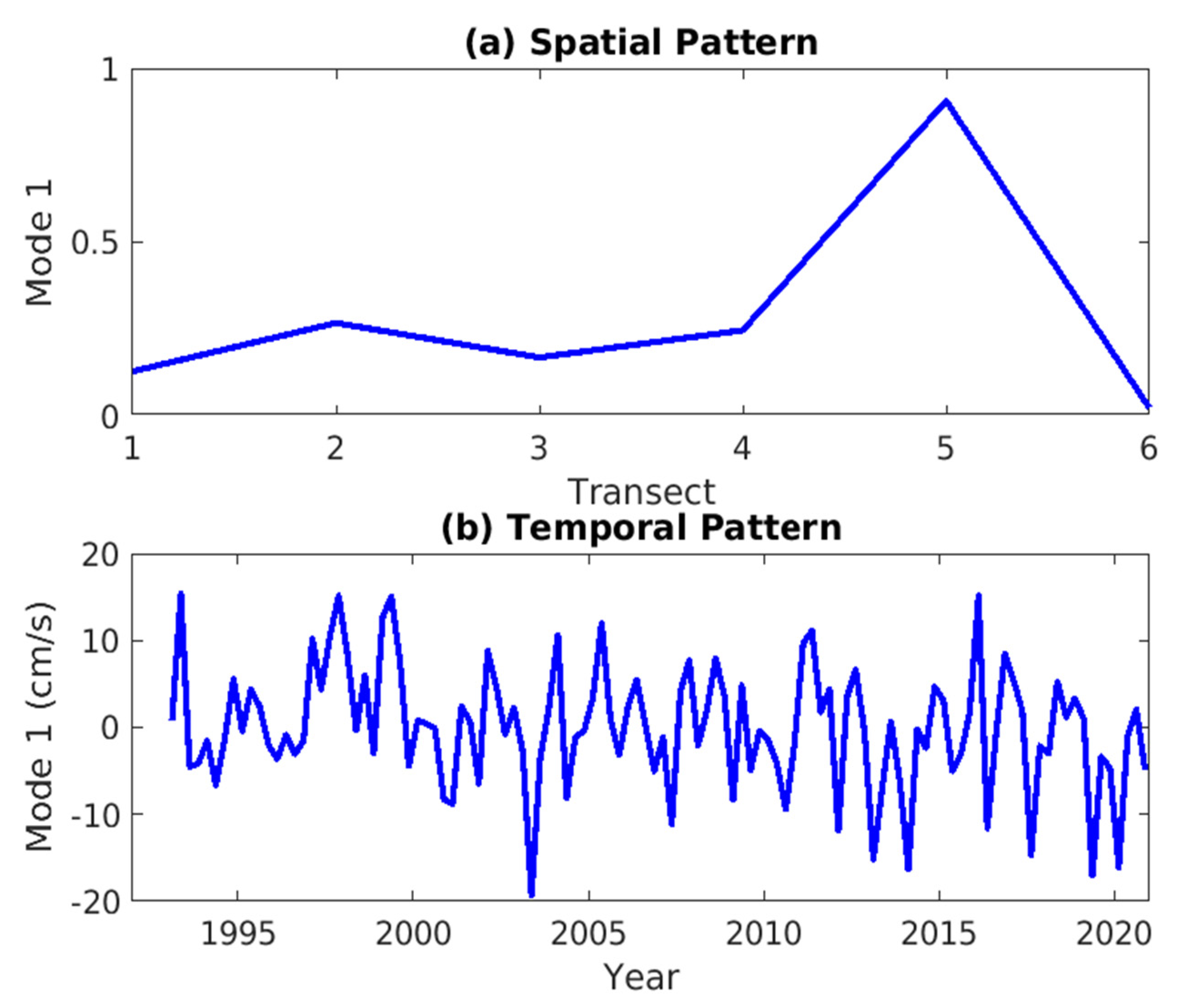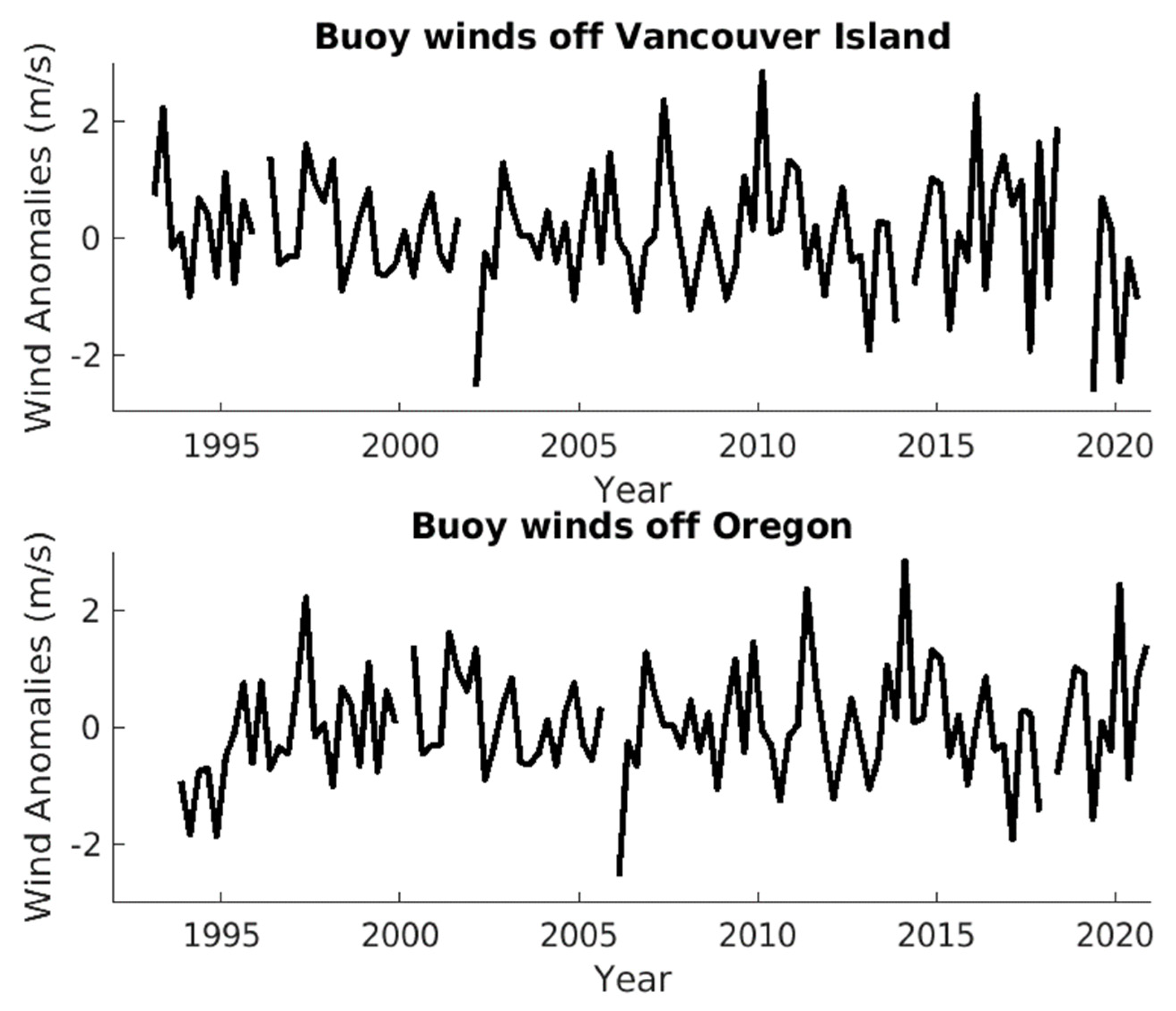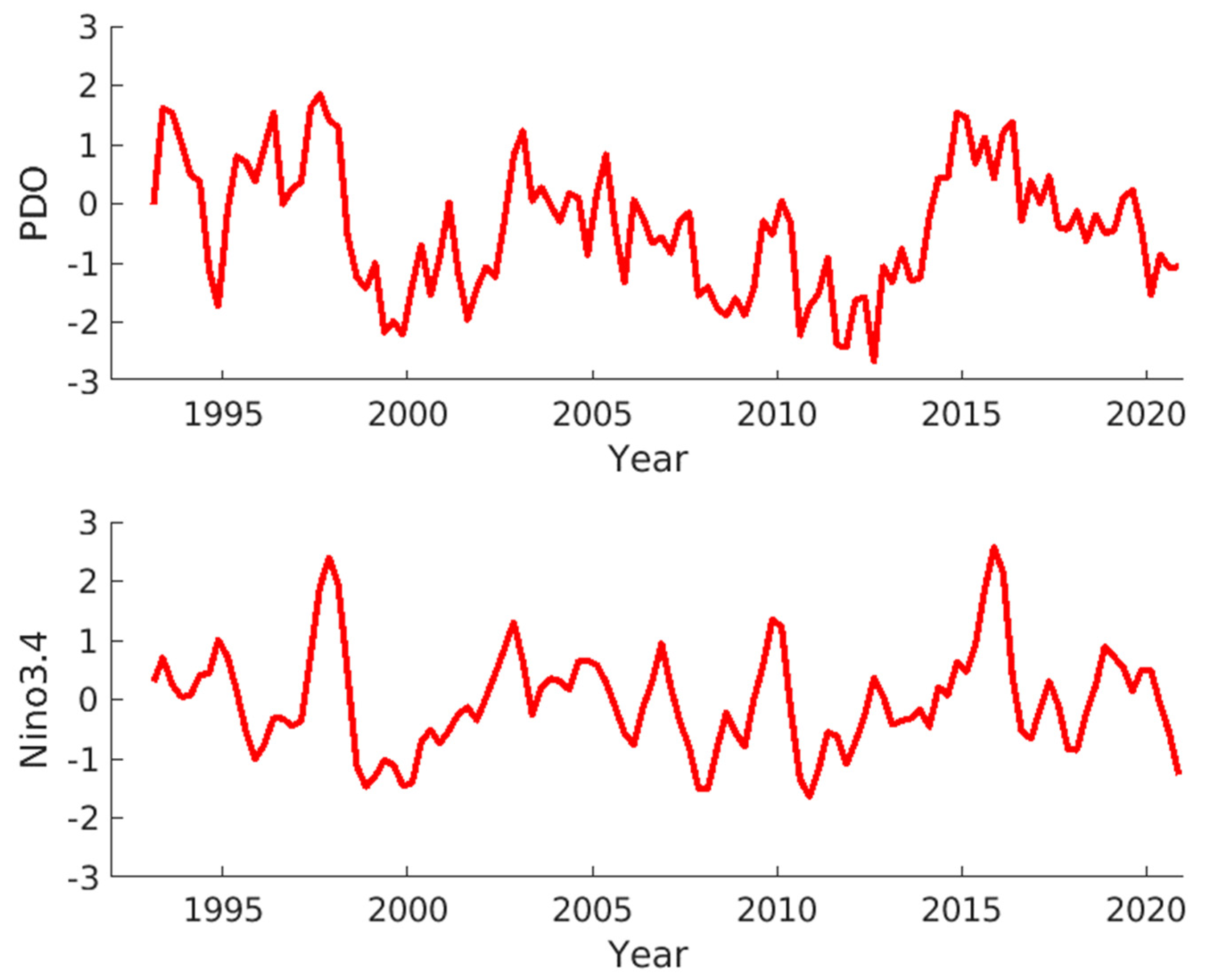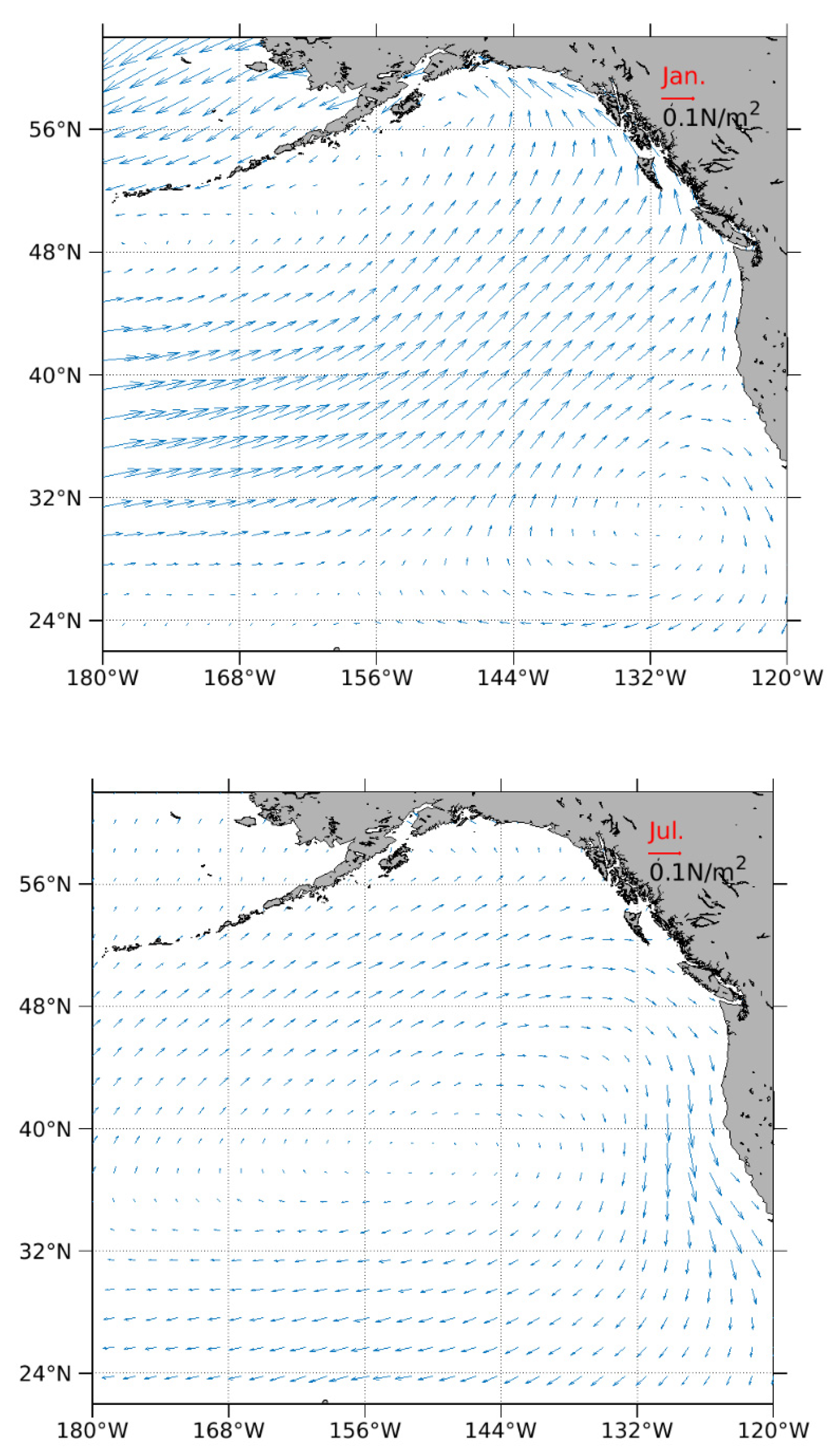1. Introduction
The shelf edge and continental slope off the west coast of Canada are located in the confluence zone of the subpolar gyre and subtropical gyre of the North Pacific. The mid-latitude eastward North Pacific Current bifurcates offshore of the shelf edge to form the equatorward California Current and the poleward Alaska Current (
Figure 1). Off South Vancouver Island, the flow on the shelf edge and continental slope is poleward in winter, and becomes equatorward in summer due to upwelling favorable winds [
1].
Moored measurements at a long-term (~30 years) monitoring site A1 off West Vancouver Island (
Figure 1) show that the near-surface current on the shelf edge has strong interannual variability, with intensified summer equatorward currents during major El Niño events [
2]. The moored measurements also indicate a complex vertical structure of the shelf-edge current. However, there are no long-term current data available for the central and northern shelf edges and continental slopes.
Numerical models (e.g., [
3]) show that the seasonal reversal of the shelf edge current can be attributed to both regional and remote forcing. They also indicate that the interannual variability of the shelf edge current may be significantly influenced by remote forcing and regional wind patterns, but not much by river runoff.
Gridded satellite altimetry data have been used to study Haida eddies off the west coast of Canada [
4]. Nevertheless, along-track altimetry with high spatial resolution has not been used to study the current on the shelf edge and continental slope. In fact, ascending ground tracks of TOPEX/Jason satellites are approximately perpendicular to the shelf-edge and slope current. Therefore, geostrophic currents calculated from along-track sea surface height can well represent surface currents along the shelf edge and continental slope.
In this study, we investigate the near-surface geostrophic current on the shelf edge and continental slope off the west coast of Canada (extended from South Vancouver Island to North Haida Gwaii) using the TOPEX/Jason satellite altimetry data from 1992 to 2020. The main objectives are to demonstrate the feasibility of using satellite altimetry to monitor shelf-edge near-surface currents off the west coast of Canada and to improve our knowledge of alongshore variations of the near-surface geostrophic currents.
3. Results
We begin with the evaluation of altimetry-derived surface geostrophic currents against current meter data. To do so, we derive the altimetric currents over a 25 km segment on the shelf-break side of the South Vancouver Island transect. The altimetric currents are compared with the 35 m current meter data at A1 (
Figure 2). It is necessary to use the 25 km shelf-break segment so that the altimetric currents represent the shelf-break current like the current meter data. The correlation coefficient between the altimetric currents and current meter data is 0.6, significant at the 99% confidence level. We also look at the ratio of the squared sum of the difference in longshore currents between altimetry and current meter data to the mean squared sum of the longshore currents from current meter data. There is complete agreement if the ratio is 0. The smaller the ratio, the better the agreement is. The ratio is calculated to be 0.76, indicating fair quantitative agreement. Therefore, the two metrics indicate that altimetric currents are reasonably good at representing seasonal and interannual changes in longshore currents.
At the South Vancouver Island transect, the winter surface current is poleward, and the summer surface current is equatorward, with the long-term mean surface current close to zero (
Figure 3). The seasonal cycle has a range of 8 cm/s. In contrast, there is a mean poleward flow of about 15 cm/s at the North Vancouver Island transect (
Figure 4). The seasonal cycle has a range of 5 cm/s. The mean flow and seasonal cycle at the Queen Charlotte Sound transect (
Figure 5), the South Haida Gwaii transect (
Figure 6), and the Central Haida Gwaii transect (
Figure 7) are qualitatively similar to those at the North Vancouver Island transect. At the North Haida Gwaii transect, the mean flow continues to be poleward, but the seasonal cycle diminishes (
Figure 8).
There is no apparent long-term trend in the surface current at all transects over 1992–2020 (
Figure 3,
Figure 4,
Figure 5,
Figure 6,
Figure 7 and
Figure 8). In contrast, interannual variations are evident, with large episodic anomalies occurring during El Niño and La Niña years. For example, stronger equatorward surface currents occurred in the summers of 2015 and 2016, and stronger poleward surface currents occurred in the falls of 2015–2016 and 2016–2017 during El Niño. In summer/fall 2020 during La Niña, the equatorward surface current at the South Vancouver Island transect was stronger than normal (
Figure 3). The seasonal anomalies at the North Vancouver Island, Queen Charlotte Sound, South Haida Gwaii, and Central Haida Gwaii transects are correlated with those at the South Vancouver Island transect, with the correlation coefficient different from zero at the 95% confidence level (
Table 1). Nevertheless, there is no correlation in the seasonal flow anomalies between the North Haida Gwaii transect and the South Vancouver Island transects at the 95% confidence level.
Further, we carried out the Empirical Orthogonal Function (EOF) analysis of the seasonal flow anomalies at the six transects. The first EOF mode accounts for 43% of the total variance. The spatial pattern of the first mode (
Figure 9a) represents the continuous shelf-edge flow from the South Vancouver Island transect to the North Haida Gwaii transect. The first-mode time series (
Figure 9b) correlates with the alongshore seasonal wind anomalies off South Vancouver Island and off Oregon (
Figure 10,
Table 2) at the 95% confidence level respectively, but it does not correlate with either seasonal PDO or seasonal Niño 3.4 indices (
Figure 11,
Table 2). The longshore currents from current meter data at A1 do not correlate with either of the two indices at the 95% confidence level, supporting the altimetric results. In addition, the second EOF mode accounting for 19% of the total variance has no correlation with either of the two indices, and the same is true for the seasonal current anomalies at the South Vancouver Island transect.
4. Discussion
Earlier studies using current meter data showed that the near-surface (35 m below the sea surface) shelf-edge current at a long-term monitoring site off South Vancouver Island is poleward in winter and equatorward in summer [
2,
8]. The present altimetry-derived surface currents at the South Vancouver Island transect near the monitoring site show a similar seasonal cycle in phase and magnitude. Furthermore, the altimetric currents show that the mean flow is poleward, except at the South Vancouver Island transect. They also show that the seasonal cycle is a coherent feature at all transects except at the most northern transect, the North Haida Gwaii transect, where the seasonal cycle diminishes.
Previous studies have identified that seasonal wind shifts are the main driver for the seasonal changes of the shelf-edge currents off Vancouver Island [
1]. In the summer, the upwelling winds dominate, and in the winter, the downwelling winds dominate over the Vancouver Island Shelf (
Figure 12). Nevertheless, the alongshore wind distribution is not the same on the entire continental shelf off the western coast of Canada. In the summer, the dominant wind is onshore instead of alongshore in the northern part of the Pacific Canadian Shelf (
Figure 12). The weak mean flow over the South Vancouver Island slope and strong poleward flow over the northern continental slope, and the coherent seasonal cycle off the west coast of Canada from satellite altimetry measurements are consistent with the previous finding that the seasonal change of the alongshore wind direction is the main driver for the longshore slope current [
1].
The interannual variations in the shelf-edge current off Vancouver Island have been linked to El Niño and La Niña events [
2]. The present altimetric results also show significant interannual flow variations at all transects. The large episodic current anomalies at the South Vancouver Island transect during El Niño (e.g., 2015–2016) and La Niña (e.g., 2020) years (
Figure 3) are consistent with Hourston and Thomson’s finding based on current meter data [
2].
The statistically significant correlation between the first-mode time series of the shelf-edge and continental slope current and the alongshore wind anomalies off the South Vancouver Island coast suggests that the interannual current variation may be partially attributed to the variation in the regional alongshore winds. Likewise, the statistically significant correlation between the shelf edge current and the remote along-shelf winds off the Oregon coast suggests an impact of the remote wind forcing, consistent with Masson and Fine’s [
3] findings on the effects of the open boundary forcing from their ocean modeling experiments. The underlying mechanism for the impacts of the remote wind forcing was explained by Battisti and Hickey [
9], which showed that a significant portion of the low-frequency variance in the longshore velocity off the Washington and Oregon coasts is accounted for by the propagating first-mode coastally trapped waves forced by remote winds farther south.
Masson and Fine [
3] showed that the interannual variations in their model currents are related to both the open boundary forcing outside Pacific Canadian shelf and slope waters and to the regional wind forcing. They further indicated the importance of the eddy variability off Haida Gwaii, which can be related to local winds and freshwater runoffs.
The surface current anomalies at the North Haida Gwaii transect are not correlated with those at the other transects, which suggests that some other factors may be locally dominant. For example, local winds and freshwater runoffs may be important at the North Haida Gwaii transect [
3]. Strong mesoscale eddy variability has been found in gridded satellite altimetry data and ocean model simulations [
3,
4], which can be aliased into interannual variability of the shelf-edge current.
Although our results indicate large episodic anomalies occurred during El Niño and La Niña years, there is no statistically significant correlation between the shelf-edge and slope current anomalies and PDO or between the shelf-edge and slope current anomalies and the Niño 3.4 index, which means that the large-scale climate effect is more complex, possibly depending on how it is manifested regionally through cascading atmospheric, hydrological, and oceanic responses [
3].
5. Conclusions
We investigated the longshore variations, seasonal cycle, and interannual changes of the near-surface geostrophic currents along the shelf-edge and continental slope off the west coast of Canada from 1992 to 2020, demonstrating the feasibility of using along-track satellite altimetry data for monitoring the near-surface shelf-edge and slope current. The investigation reveals some different characteristics of the near-surface shelf-edge and slope current from the south to the north.
The surface current is poleward in winter and equatorward in summer off South Vancouver Island, and is poleward year-round at the rest of the transects. The seasonal cycle clearly exists, except at the North Haida Gwaii transect.
The seasonal current anomalies have longshore correlations from the South Vancouver Island transect to the Central Haida Gwaii transect that are significant at the 95% confidence level, except at the North Haida Gwaii transect. They are significantly correlated with the longshore wind anomalies off both South Vancouver Island and Oregon at the 95% confidence level.
The seasonal current anomalies show large episodic changes during strong El Niño and La Niña years. However, they are not correlated with either the Niño 3.4 index or the PDO index at the 95% confidence level.
